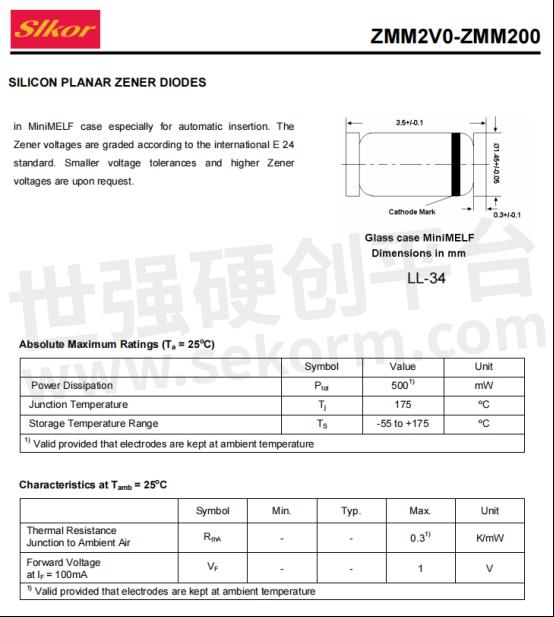In-depth Analysis of the Characteristics and Key Parameters of the ZMM8V2 Zener Diode

In the electronics industry, the Zener diode (also known as a Voltage Regulator Diode) is a crucial component primarily used to provide a stable reference voltage within a circuit. Today, we will focus on the ZMM8V2 Zener diode, examining its key parameters such as regulation voltage, power rating, reverse current, and its significant role in practical applications.

SLKOR Voltage Regulator Diode ZMM8V2 product photo
1. Basic Parameters of the ZMM8V2 Zener Diode
The ZMM8V2 is a high-performance Zener diode with a nominal regulation voltage of 8.2V. This means that under normal operating conditions, this diode can maintain an output voltage of approximately 8.2V consistently. The regulation voltage range is between 7.7V and 8.7V, allowing for slight adjustments within this range to meet varying circuit requirements.
Besides the regulation voltage, the power rating of the ZMM8V2 is another vital parameter. It has a power rating of 500mW, indicating that the diode can handle a maximum power dissipation of 500 milliwatts. In practical applications, it is essential to ensure that the circuit's power does not exceed this value to avoid damaging the diode.
Another critical parameter is the reverse current (Ir). For the ZMM8V2, the reverse current at a 6.2V reverse voltage is 100nA (nanoamperes). This low value signifies minimal leakage current under reverse bias conditions, thus ensuring the stability and efficiency of the circuit.

Slkor Voltage Regulator Diode ZMM8V2 specification

Parameters of Slkor Voltage Regulator Diode ZMM8V2
2. Applications of the ZMM8V2 Zener Diode
The ZMM8V2 Zener diode is widely used in various circuits requiring a stable voltage, such as power supply circuits, protection circuits, and signal processing circuits. In power supply circuits, it ensures a stable output voltage, protecting subsequent circuits from voltage fluctuations. In protection circuits, it acts as a voltage limiter, preventing excessive voltage from damaging other components. In signal processing circuits, it serves as a reference voltage source, providing a stable baseline for signal processing.
3.Load Capacity of the Zener Diode
The load capacity of a Zener diode refers to the maximum current it can deliver under various load conditions. This capacity depends on several parameters and characteristics of the Zener diode.
Basic Concepts and Working Principle:
A Zener diode, also known as a voltage regulator diode, is a semiconductor device with voltage regulation properties. When the diode is reverse biased and the reverse voltage exceeds a specific threshold, the Zener voltage, the reverse current increases sharply, providing voltage regulation.
Factors Determining Load Capacity:
● Size and Structure: The size and structure of the Zener diode directly impact its load capacity. Generally, larger diodes have a higher load capacity.
● Operating Temperature: The operating temperature significantly affects the load capacity. For instance, the maximum allowable power rated at 25℃ decreases in high-temperature environments.
Technical Parameters:
● Rated Current (IR): The maximum current the Zener diode can withstand. Exceeding this current may damage the diode.
● Rated Power Dissipation (PR): The maximum power dissipation the Zener diode can handle. Exceeding this power dissipation may cause the diode to overheat and potentially fail. This parameter is typically determined by the product of the Zener voltage (Vz) and the maximum allowable current (Izm).
Maximum Allowable Power:
The maximum power the Zener diode can handle under specific conditions. Generally, the higher the maximum allowable power, the greater the load capacity. Common Zener diodes have a maximum allowable power ranging from 0.5 watts to 5 watts.
Specific Values for Load Capacity:
Due to the varying load capacities of different Zener diode models and specifications, it is not possible to provide a universal value. However, you can evaluate the load capacity of a specific Zener diode based on the technical parameters mentioned above (such as rated current and rated power dissipation).
Summary and Conclusion:
The load capacity of a Zener diode depends on multiple factors, including size, structure, operating temperature, and technical parameters. In practical applications, to ensure circuit stability and reliability, it is crucial to select the appropriate Zener diode model and specification based on the load current and operating environment. Particularly when using Zener diodes in high-temperature environments, it is essential to account for the reduced load capacity and implement adequate cooling measures.
- +1 Like
- Add to Favorites
Recommend
This document is provided by Sekorm Platform for VIP exclusive service. The copyright is owned by Sekorm. Without authorization, any medias, websites or individual are not allowed to reprint. When authorizing the reprint, the link of www.sekorm.com must be indicated.










































































































































































































































































































































































































































































































































































































































































































































































































































































































































